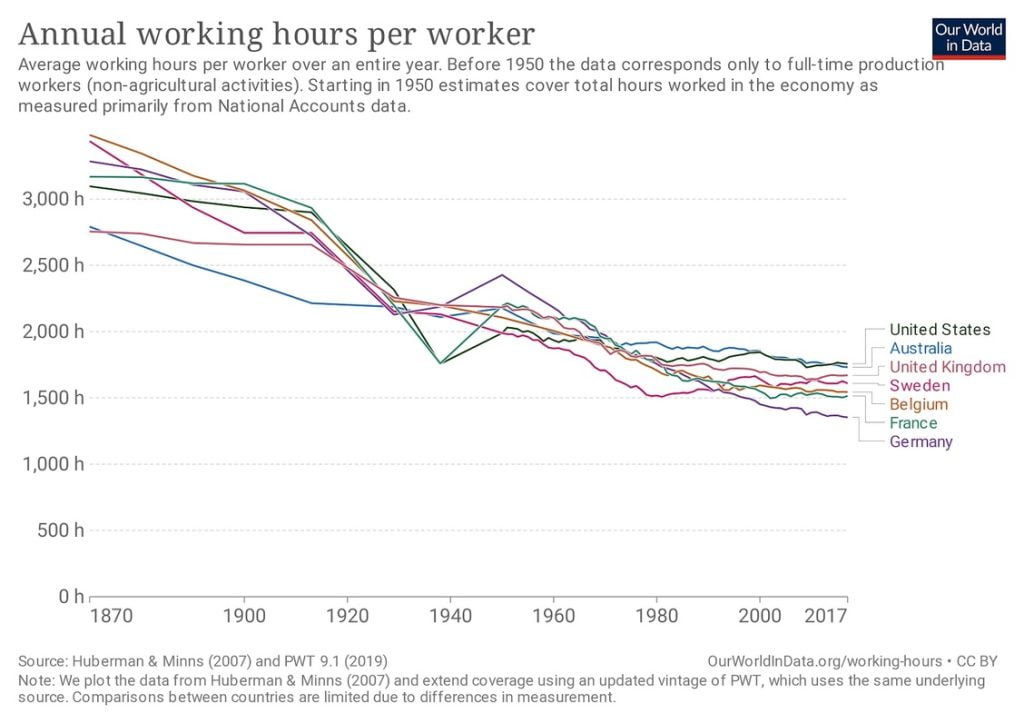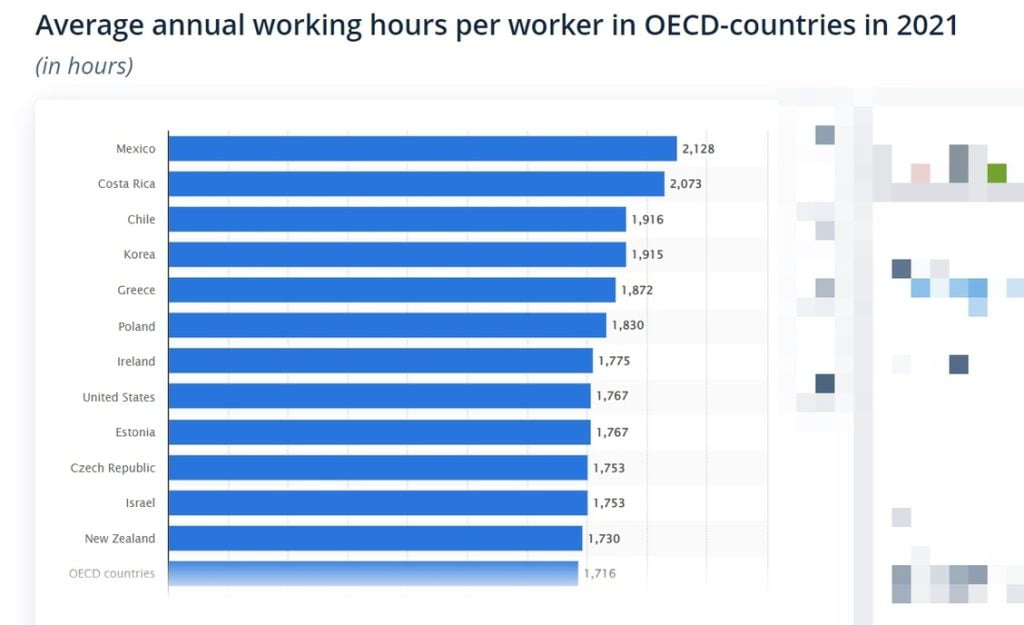
Understanding how many work hours in a year you actually spend on the job could make a huge difference in balancing your professional and personal life.
From insufficient breaks to limited personal time, today’s work environment often creates challenges for both employees and freelancers. Many workers, especially those working remotely, rarely take the time to calculate their total annual work hours. We’ve become so absorbed in our tasks that we struggle to take proper breaks or fully disconnect from work when we should.
That’s why it’s important to get your hands on data such as annual working time to put things in perspective.
Companies can also take advantage of calculating annual work time. From perfecting their budget to assessing their workforce, there’s much to glean from evaluating average hours worked in a year.
Introduction to Hours Worked
Understanding the number of hours worked in a year is essential for both employees and employers. It plays a crucial role in calculating annual salaries, determining work-life balance, and making informed decisions about work schedules and productivity. According to the U.S. Bureau of Labor Statistics, the average annual working hours for a full-time employed person in the United States is approximately 1,768 hours.
To calculate the total hours worked in a year, you need to consider the number of hours worked per week, the number of weeks worked per year, and the amount of paid time off, including holidays and vacation days. This comprehensive understanding helps in planning and optimizing both professional and personal life.
Explaining Working Hours
Working hours involve the amount of time employees spend working. But it’s not the same for everyone. Some workers are paid by the hour and others are paid monthly or weekly (full-time workers). There are others though, who are paid on a contract basis. That is, upon fulfillment of a project or duty.
For example, a consultant may be paid a one-time fee to deliver on a project. Athletes are also typically paid weekly, without deductions for days off. Part-time workers, on the other hand, typically work fewer hours per week compared to full-time employees, which can affect their benefits eligibility and work-life balance.
Then, there are salaried workers in countries like the US who are paid their wages as long as they work the required amount of time each week. Salaried employees can determine their hourly wage by calculating their annual salary in relation to the total hours worked in a year, which helps in assessing work-life balance and financial planning.
Understanding Work Schedules
Work schedules can vary significantly depending on the industry, job type, and employer. A standard full-time workweek typically consists of 40 hours, which translates to 8 hours per day, 5 days a week. However, some jobs may require more or fewer hours, and some employers may offer flexible schedules or remote work options.
Understanding work schedules is crucial for calculating total hours worked in a year and determining work-life balance. The Fair Labor Standards Act (FLSA) does not define the exact number of work hours a full-time or part-time employee must clock in, but it does provide guidelines for overtime pay and minimum wage. This flexibility allows for a variety of work arrangements that can cater to different needs and preferences.
Online Work Hours Calculator
If you want a quick and simple way to calculate how many work hours are in a year in your given circumstances, but don’t want to get pen and paper (or a spreadsheet) involved, here’s a simple calculator to help you do just that:
Annual Work Hours Calculator
How to Calculate Working Hours Per Year: A Breakdown
Full-time employees who work the typical 9 to 5 schedule work 8 hours per day. That means they work 40 hours each week.
Since one year has 52 weeks, they’d work 2,080 hours per year. This is calculated by multiplying the weekly hours by the number of weeks in a year, or 40 hours per week x 52 weeks.
While that may solve the equation for the average worker, it’s not that simple. People almost never work the entire 40 hours per week for 52 weeks.
Organizations account for time off, whether paid or unpaid, throughout the year. These time off periods cover paid holidays, sick days, absences, and paid time off. Therefore, the yearly work hours for an employee can be less than the calculated total.
So, if you work 2,080 hours a year, then you’re likely missing out on some benefits and should chat with your employer.
For example, if you have 12 PTO days and the regular 8 paid holidays, you’ll have worked 1,920 hours for the year. Still, paid time off and holidays vary from company to company. You may also want to factor in unpaid sick days in some organizations, which employers are mandated by law in some countries to recognize. When every time off work is accounted for, the annual average will reduce even further.
Understanding your total annual work hours is crucial for productivity assessment, financial planning, and achieving a better work-life balance.
How the Average Working Week is Calculated
Calculating your average working week, including your weekly working hours, allows you to easily determine how much time you work in a year.
For some countries, it’s as easy as multiplying the hours worked each day by 5. For others, it’s quite different. A common method is to use ‘hours per week x 52’ to calculate annual work hours.
You have to consider that some countries don’t use the traditional 5-day workweek and others adopt different systems for calculating working time.
For example, the UK uses rules outlined in the Working Time Regulations to help workers determine their average working hours per week.
According to the rules, UK workers use a 17-week rolling reference period to calculate the average time worked each week.
It works by adding up all your work time during the last 17 weeks and then dividing the result by 17.
If you were on leave or absent due to illness during the last 17 weeks, the reference should start earlier to make up for the days you didn’t work.
Employees can use a 26-week reference period instead if there’s an emergency. Also, workers like caretakers, security guards, and those who travel long-distance can use the 26-week rolling reference period.
Paid Holiday, Paid Time-Off, Unpaid Time-Off
Whether you’re an employee or employer, understanding the difference between paid time off and paid holidays is crucial. These off days are critical to calculating annual working time.
Some countries, like the US, don’t have federal laws mandating employers to provide paid time off. That said, organizations typically offer these benefits to compete for and retain talent.
They provide an average of 10 days of paid time off. These days cover things like vacations, sick days, and personal days.
Paid holiday days include national public holidays set by the federal government. Holidays recognized in the US include:
- Independence Day – 4 July
- Juneteenth – 19 June
- Memorial Day – 29 May
- Labor Day – 4 September
- Inauguration Day – 20 or 21 January
- President’s Day – 20 February
- Martin Luther King Day – 16 January
- New Year’s Day – 1 January
Note that private businesses can choose to require employees to show up to work during national holidays.
Unpaid Time Off and How It Affects Working Hours
Companies are obligated under federal and state laws to provide unpaid time off for cases such as illness and other personal obligations.
The United States, under the Fair Labor Standards Act (FLSA), mandates qualified employers to offer qualified employees up to 12 weeks of annual unpaid leave in any of the following events:
- The birth of a child
- Adoption or placement of a foster child
- Provision of care to an immediate family member
- Illness
It is also important to consider non working hours when calculating total annual work hours, as these periods contribute to overall work-life balance and planning leisure time.
However, some companies offer paid maternity and paternity leave of absence when parents welcome new children.
Employment contracts often specify the required working hours, which can vary significantly across different professions. More demanding roles typically require longer working hours, impacting employee engagement and productivity. You’d have to account for these periods away from work when calculating yearly working time.
Understanding Federal Holidays
Federal holidays are public holidays recognized by the federal government, and they can affect the total number of hours worked in a year. There are 11 federal holidays in the United States, including New Year’s Day, Memorial Day, Independence Day, and Christmas Day. While federal employees are entitled to paid holidays, private industry workers may or may not receive paid holidays, depending on their employer’s policies.
Understanding federal holidays is essential for calculating total hours worked in a year and determining paid time off. These holidays provide an opportunity for rest and rejuvenation, contributing to a healthier work-life balance.
Steps in Calculating Annual Hours
These steps will show you how to calculate work hours to determine your average hours worked in a year. By following these guidelines, you can ensure accurate calculations of your total working hours, taking into account individual work schedules, holidays, and paid time off (PTO).
What Are Your Weekly Hours?
Start by determining how much time you work each week.
To do that, multiply your daily average by 5. So, if you work 8 hours a day, that means you work 40 hours per week. This calculation of weekly work hours is essential for determining your annual working hours.
However, if your daily schedule fluctuates, take note of your work hours and add them at the end of the week. You can then add everything up and divide by 5 (or the number of days you work in a week) to get your daily average.
After getting your daily average, multiply by 5 to get your weekly hours. Then, use the formula ‘hours per week x’ the number of weeks in a year to calculate your annual work hours. Remember to account for factors like part-time schedules, PTO, and holidays, which can impact your total working hours.
If you work in the UK, you have to use the 17-week reference period to calculate your weekly average. To do that, you have to add up all the time you worked over the last 17 weeks and divide the result by 17.
If you had to stay off during the last 17 weeks, start from an earlier date to make up for the time off work.
Multiply By 52
Once you’ve calculated your weekly average, multiply the number by 52. This is often referred to as the ‘week x 52 weeks’ method for calculating annual work hours.
So, for example, 40 hours per week x 52 weeks gives you 2,080 hours a year.
Calculate Your PTO
Organizations have different paid time off policies. Some companies choose to combine vacation time and sick leave as paid time off. Additionally, many companies offer a set number of paid vacation days annually, which significantly impacts the total annual work hours.
Calculating your paid time off involves multiplying the number of days you spend away from work by how many hours you work per day on average. This calculation should also consider sick time to provide a comprehensive view of your total annual work hours.
So, if you have 15 days a year in your paid time off package and you work 8 hours a day, your PTO for the year is
15 x 8 = 120 hours.
Deduct Your Total Time Off From Your Total Annual Hours
Now, add the entire amount of time you spend off work, including both paid or unpaid time, and then subtract the total from your annual hours.
Here’s an example:
If your PTO is 120 hours, you had 8 paid holidays, and 7 unpaid personal leave days, you have to calculate like this:
120 + (7 x 8) + (8 x 8) = 240 hours.
Subtracting from a total of 2,080 hours gives you 1840 hours of actual working time, considering non working hours for accurate calculations.
Using a Time Tracker
Timesheets make work week calculations easier, especially for workers paid by the hour.
These days, time trackers are now a staple of work. Employees use these digital applications to calculate billable time and monitor employee efficiency.
Time tracking software is now so thorough that you can use it to easily calculate annual work hours. The data can be further broken down into months, weeks, and days. You can also use them to calculate PTO and paid holidays.
One of the best time trackers you can use to keep tabs on annual working time is Traqq time tracking. The tool allows you to use all its premium features for free if you’re working with fewer than 3 team members.
Using these tools, you can accurately calculate work hours, ensuring you account for vacations, sick days, and other time off.
Facts and a Bit of History About Working Hours
Working times have changed throughout history. Humans have evolved when it comes to balancing the scales between productivity and quality of life, transitioning from longer hours to the standard 40-hour workweek.
Our forefathers generally worked more than we currently do, and looking at historical data shows us how far we’ve come.
The typical Monday to Friday, 9 to 5 work arrangement wasn’t always the way to work. Life circumstances and historical events largely determined that schedule, with the eight hours per day becoming a common standard for full-time employees.
Humans recorded the highest number of working time during the Industrial Revolution before revising how much time they put into work.
Data suggests that our ancestors worked about 1,773 hours per year on average during the prehistoric era, and that number rose to 3,346 at the peak of the industrial revolution in the 1840s.

Today, the highest number of working hours per year is the UAE’s 2,735 hours, according to the International Labor Organization.
Working Hours by Developed Economies
Every country has a different work culture, which goes on to affect the average number of working hours.
So, a key point to consider when calculating annual work time is where you live.
Workers in less developed countries tend to work longer than those in wealthier nations. The disparity is largely due to economic infrastructure and the availability of part-time work.
That said, there have been significant shifts in the number of working time in different countries over the years. While some countries have seen working time drastically reduce over the decades, others have either leveled off or slightly increased the amount of time they work each year.
For example, Chinese workers went from an average of 1,976 annual working hours in the 1970s to 2,174 hours in 2017. On the other hand, workers in Germany reduced annual work hours to 1,354 in 2017 from about 2,500 in the 1950s.
Source: Our World in Data
Still, some countries record high annual working time. For example, Mexican workers worked an average of 2,128 hours a year, the highest for any OECD country as of 2022.

Source: Statista
Paid Vs Unpaid Working Hours
Most companies provide generous paid time off for workers today, allowing them enough time to recharge.
That means, even after subtracting your vacation days, you’re likely paid for the entire 2,080 typical annual work hours if you work 40 hours each week. However, it’s important to consider both paid or unpaid time when calculating total annual work hours, as holidays and other forms of time off can significantly affect this figure.
That said, some companies will deduct your pay if you take extended sick leave or stay away from work for personal obligations such as providing care for an immediate family member.
So, if you’re calculating how many working hours in a year are paid for, be sure to deduct unpaid time. Additionally, understanding your hourly wage is crucial for accurately determining your annual income, as it helps in budgeting and maintaining a work-life balance.
Importance of Calculating Yearly Working Hours
Calculating the time worked per year is important to employers and employees, especially in organizations where workers are paid by the hour. Understanding yearly hours is crucial for ensuring a better work-life balance and compliance with labor regulations.
Full-time employees who have a fixed work schedule can work extra time occasionally without extra pay. That said, additional employee benefits like health insurance and paid time off tend to be justifiable trade-offs.
On the other hand, contract workers don’t get these benefits, so it’s imperative that they’re fully compensated for overtime.
But there’s more to calculating total work hours for employers and employees than overtime. Let’s go through those benefits.
Understand Your Earning Power
Employees who work by the hour will be able to make accurate estimates of their annual income by calculating how many hours they work in a year, which helps in determining their annual salary.
Understanding your hourly pay is crucial for assessing your earnings and making informed financial decisions.
Using time tracking software can significantly boost productivity by providing detailed insights into how time is spent. Having this data can help them make better budgeting plans and saving arrangements. They can create a better outlook for the upcoming year and figure out how to manage finances.
It also puts other things like overtime in perspective, allowing users to accurately calculate work hours, including accounting for time off such as vacations and sick days. This ensures precise tracking and better management of both personal and employer contexts.
Breakdown of Hourly Rates
Full-time employees can use data from calculating annual working time to understand how many hours they work each day, week, and month. This information is crucial for understanding their hourly wage and how it translates to their overall earnings.
These numbers can help make things look clearer. For example, they get to understand if they’re being paid adequately by calculating their annual income based on their hourly pay.
Better Use of Leave and Time Off
Your annual working hours can help you understand if taking time off impacted your earnings or if you didn’t take enough time to rest in the course of a year. This includes considering paid vacation days, which are often provided by companies but not mandated by federal law in the US.
It also helps you to take full advantage of all your paid time off and holidays.
That means you have to thoroughly go through your company’s PTO policies to fine-tune your vacation plans for the upcoming year. You also have to consider unpaid time off policies and know when to take those days off.
For companies, calculating annual work time helps put PTO policies in perspective. They can use this data to create better policies and improve existing ones, including considerations for sick time.
Better Understanding of Workforce and Resources
A company can evaluate its human resource capabilities by looking at annual working time and considering the work environment factor. This includes flexibility in work schedules, the rise of freelance opportunities, and the use of time tracking tools to monitor productivity. These factors help organizations adapt to remote work and personalized hours, contrasting with traditional work structures that impose standard hours. Annual working hours also help them draw better budgets for future fiscal years.
Understanding workforce needs also involves differentiating between full-time and part time employees. Part time employees typically work fewer hours per week and year compared to full-time employees, and their eligibility for benefits may differ. This distinction is crucial for determining how many more workers may be needed to handle future projects.
Tracking team productivity and performance is crucial for any business. Utilizing time tracking software can significantly enhance this process by providing accurate data on how time is spent on various tasks. This software helps in identifying areas where efficiency can be improved and ensures that all team members are contributing effectively to the project goals.
To effectively manage your team’s productivity, it’s essential to calculate work hours accurately. Time tracking tools can assist in this by offering detailed methodologies for determining work hours over different periods, such as monthly, quarterly, and annually. These tools also account for time off, including vacations and sick days, ensuring that the total work hours are precise. By using these tools, both personal and employer contexts can benefit from accurate work hour calculations, leading to better planning and resource allocation.
Evaluate Work-Life Balance
Knowing how much time you work per year can help you create a better work-life balance by allowing you to plan and maximize your free time effectively. Evaluating how much you’re putting into work allows you to determine whether you’re taking enough breaks. That way, you can start making decisions and resolutions to use up more of your paid time off. You can also commit to going on more vacations and understanding your non working hours to maintain a healthy lifestyle.
Plan for Other Activities
Calculating your annual work time shows how much time you have for your personal life. Looking at the data can help you figure out how to make more time for other extracurricular activities such as exercising, socializing, and even volunteering.
Plan for Other Activities
Calculating your annual work time shows how much free time you have for your personal life. Looking at the data can help you figure out how to make more time for other extracurricular activities such as exercising, socializing, and even volunteering.
Understanding your non working hours is crucial for planning personal activities. It allows you to recognize the total hours you do not spend working during the year, aiding in achieving a balanced work-life dynamic and maintaining a healthy lifestyle.
Best Practices for Calculation
Calculating total hours worked in a year requires careful consideration of several factors, including work schedules, paid time off, and holidays. Here are some best practices for calculation:
- Determine the number of hours worked per week and the number of weeks worked per year.
- Calculate the total hours worked per year by multiplying the number of hours worked per week by the number of weeks worked per year.
- Subtract the total hours of paid time off, including holidays and vacation days, from the total hours worked per year.
- Use time tracking software to simplify the calculation process and ensure accuracy.
By following these best practices, employees and employers can accurately calculate total hours worked in a year and make informed decisions about work schedules and productivity. This approach ensures that all factors are considered, leading to more precise and useful calculations.
Common Mistakes to Avoid
When calculating total hours worked in a year, there are several common mistakes to avoid:
- Failing to account for paid time off, including holidays and vacation days.
- Not considering the number of weeks worked per year.
- Using incorrect hourly rates or annual salaries.
- Not accounting for overtime hours or non-work hours.
- Not using time tracking software to simplify the calculation process.
By avoiding these common mistakes, employees and employers can ensure accurate calculations and make informed decisions about work schedules and productivity. Additionally, understanding the concepts of work-life balance, healthy work-life balance, and better work-life balance can help individuals prioritize their well-being and make informed decisions about their work schedules. Accurate calculations are key to achieving a balanced and fulfilling professional and personal life.
In Conclusion
While calculating your annual work hours, you should also accommodate for variations in working days per year due to different weekend dates.
So, check for these variations when using estimated work hours for the next year to plan your activities, vacations, goals, and milestones.




